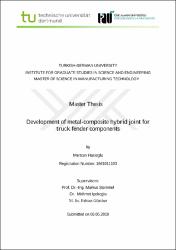| dc.contributor.advisor | Stommel, Markus | |
| dc.contributor.advisor | İpekoğlu, Mehmet | |
| dc.contributor.author | Hacıoğlu, Mertcan | |
| dc.date.accessioned | 2020-06-29T10:54:09Z | |
| dc.date.available | 2020-06-29T10:54:09Z | |
| dc.date.issued | 2019 | |
| dc.identifier.citation | Hacıoğlu, M. (2019). Development of metal-composit hybrid joint for truck fender components.Türk-Alman Üniversitesi, Fen Bilimleri Enstitüsü, İstanbul. | en_US |
| dc.identifier.uri | https://hdl.handle.net/20.500.12846/94 | |
| dc.description.abstract | The lightweight design is a general concern in many industries. The aim is reducing the weight without any loss of strength and durability. Fiber reinforced composite materials come forward due to their high stiffness to weight ratio in order to satisfy this aim. The necessity of using a composite material with a metal component can be arisen in certain applications and an applicable connection is required between them. Using fasteners or adhesive is commonly used method; however, it requires additional assembly process and the fasteners bring extra weight. An intrinsic hybrid joint, which is making an assembly of two different components in a production stage, is more effective in terms of process steps and cycle time. Development of a hybrid joint between two hollow components and product development are the main concerns of this thesis. The application example was chosen as a truck fender holder and a console of a truck from Mercedes-Benz. Combination of grooving or alternatively turning and injection molding was chosen as production and joining processes. Two groove types, which are ball end groove and U groove, were investigated in terms of mechanical interlocking and tensile test analyses were performed to see the effect of type and width of the groove on the mechanical interlocking. Additionally, bending analyses were conducted to design the required support for the hybrid joint from outside. Lastly, compression analyses were performed to simulate the torque applied to the fasteners to mount the console to the chassis. After finalizing the design with feedbacks from these analyses, four different analyses defined by Mercedes-Benz Turk were conducted to verify the usability of the developed product and the joint method. The result of the analyses showed that developed hybrid joint and new design are able to carry the defined load and the component, which is currently in use, can be replaced with the new design. | en_US |
| dc.description.abstract | Mukavemet ve dayananıklık özelliklerinden kaybetmeden düşük ağırıklı tasarım yapmak birçok endüstrinin ortak ilgi alanıdır. Elyaf destekli kompozit malzemeler yüksek sertlik/ağırlık oranından dolayı bu konuda öne çıkmaktadır. Kompozit malzemeyi başka bir metal parça ile kullanma gerekliliği belli uygulamalarda gerekli olmakta ve bu durum iki parça arasında uygulanabilir bağlantı kurulmasını gerektirmektedir. Bağlantı elemanı veya yapıştırıcı kullanımı yaygın olarak uygulanmakta olup bu işlemler eksta işçilik gerektirmenin yanında ağırlığı da arttırmaktadır. Üretim aşamasında iki parça arasında kurulan hibrit bağlantı üretim adımları ve çevrim süresi açısından verimlidir. İki silindrik parça arasında hibrit bağlantı kurulması ve paralelinde ürün geliştirilmesi bu tez çalışmasının ana konusudur. Uygulama parçaları olarak Mercedes-Benz Türk firmasına ait kamyon parçalarından çamurluk taşıyıcı boru ve konsol seçilmiştir. Kanal açma ve enjeksiyon kalıplama üretim ve birleştirme yöntemi olarak seçilmiştir. Yuvarlak uçlu kanal ve U kanal olmak üzere iki tip kanal tipi mekanik kilitleme açısından karşılaştırılmış ve kanal genişliğinin etkisini incelemek için çekme analizi yapılmıştır. Ayrıca bükme analizi ile hibrit bağlantının dikey kuvvetlere olan dayanımı ölçülmüştür. Basma analizi ile de bağlantı deliklerinin dayanımı değerlendirilmiştir. Sonlandırılan tasarıma Mercedes-Benz Türk tarafından tanımlanan doğrulama analizleri uygulanmış ve yeni tasarımın uygulanabilirliği gösterilmiştir. | en_US |
| dc.language.iso | eng | en_US |
| dc.publisher | Türk-Alman Üniversitesi | en_US |
| dc.rights | info:eu-repo/semantics/openAccess | en_US |
| dc.subject | Cam elyaf kompozitler | en_US |
| dc.subject | Glass fiber composites | en_US |
| dc.subject | Polimer enjeksiyonu yöntemi | en_US |
| dc.subject | Polymer injection method | en_US |
| dc.title | Development of metal-composit hybrid joint for truck fender components | en_US |
| dc.title.alternative | Kamyon çamurluk parçaları için metal-kompozit hibrit bağlantı geliştirme | en_US |
| dc.type | masterThesis | en_US |
| dc.relation.publicationcategory | Tez | |
| dc.contributor.department | TAÜ, Fen Bilimleri Enstitüsü, İmalat Teknolojisi Ana Bilim Dalı | en_US |
| dc.contributor.institutionauthor | Hacıoğlu, Mertcan | en_US |

















